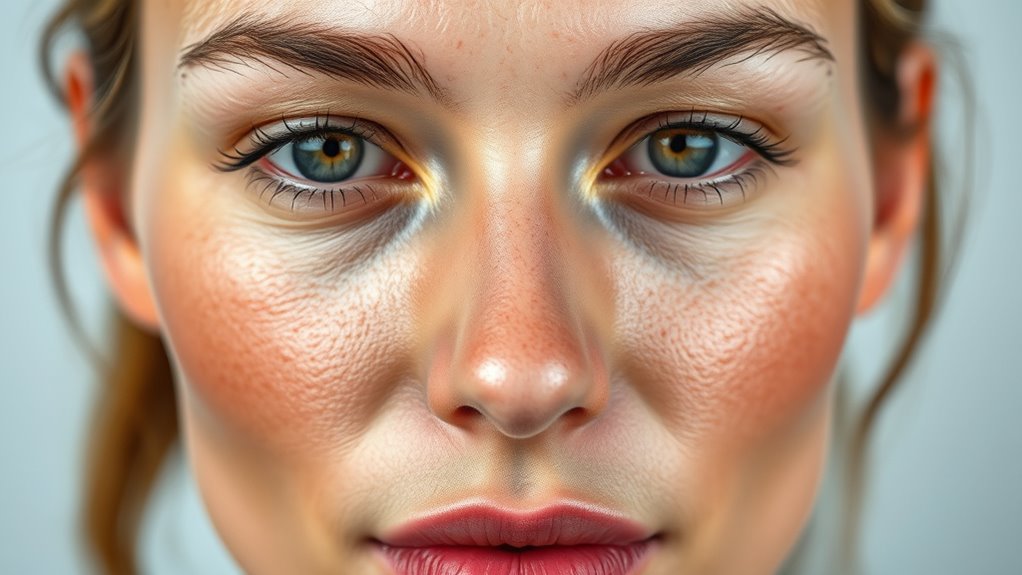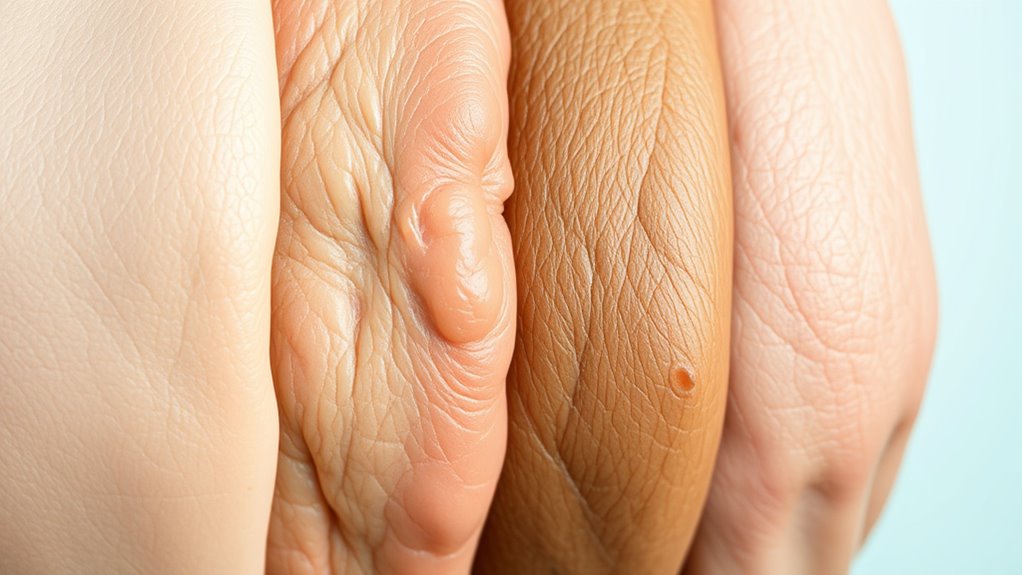Understanding your skin type is key to choosing the right skincare routine. If your skin is oily with larger pores and visible shine, you may need products that control oil without over-drying. If it’s dry or sensitive with smaller pores, focus on hydration and gentle care. Recognizing these traits helps you pick effective products and improve your skin’s health. Keep exploring to learn how to tailor your routine for your unique skin needs.
Key Takeaways
- Recognize skin types by assessing oil production, pore size, and sensitivity to tailor effective skincare routines.
- Larger pores and excess oil often indicate oily skin, requiring balancing and oil-control products.
- Dry or sensitive skin benefits from hydration and gentle cleansing to prevent irritation and flakiness.
- Understanding individual skin traits helps choose suitable ingredients, avoiding over-drying or aggravating the skin.
- Personalized skincare promotes healthier, balanced skin by addressing unique features like pore size and oil levels.

Have you ever wondered why your skincare products work better for some people than others? The truth is, everyone’s skin is unique, and understanding what makes your skin different can help you choose the right products and routines. A big part of that is knowing about your pore size and oil production. These two factors play a *vital* role in how your skin looks and responds to skincare. Pore size, for example, can influence how much your skin appears smooth or textured. Larger pores tend to be more visible and can trap dirt and oil more easily, often leading to breakouts and blackheads. If your pores are more prominent, you might notice that your skin appears oilier or shinier throughout the day, especially in your T-zone, which includes your forehead, nose, and chin.
Understanding your pore size and oil production helps tailor your skincare for better results.
Oil production is another key aspect. Some people naturally produce more oil, making their skin feel greasier and more prone to acne, while others produce less oil, resulting in dry or flaky skin. If you’re someone with high oil production, your skin may seem to shine excessively, and you might struggle with blackheads or pimples, particularly if your pores are also larger. Conversely, if your oil production is low, your skin might feel tight, dull, or sensitive, and you may notice more flakiness or redness. Knowing whether your skin is oily, dry, or somewhere in between helps you understand why certain products work well or fall short.
The relationship between pore size and oil production isn’t just about appearance; it also impacts how your skin reacts to skincare ingredients. For instance, those with larger pores and higher oil output need products that help control oil without over-drying, which can cause your skin to produce even more oil as a protective response. On the other hand, people with smaller pores and lower oil production should focus on hydration and gentle cleansing to avoid exacerbating dryness or irritation. By understanding your pore size and oil levels, you can tailor your routine more effectively, whether that’s using a clay mask to reduce excess oil or a hydrating serum to boost moisture.
Ultimately, recognizing your skin’s unique characteristics allows you to make smarter choices and see better results. When your skincare routine aligns with your pore size and oil production, products work more efficiently, and your skin can look healthier and more balanced. It’s about respecting what your skin needs and not just following generic advice. With a little insight into these factors, you’ll be better equipped to care for your skin in a way that’s truly suited to you.
Frequently Asked Questions
How Can I Tell if My Skin Is Sensitive or Reactive?
To determine if your skin is sensitive or reactive, pay attention to how it reacts to products or environmental factors. If you notice redness, burning, or skin irritation after using certain ingredients, it indicates ingredient sensitivity. You might also experience frequent reactions to skincare or weather changes. Keep track of these responses, and consult a dermatologist if you suspect your skin is reactive, so they can recommend suitable products and routines.
What Ingredients Should I Avoid for Oily Skin?
Oily skin doesn’t mean you should welcome everything greasy. Avoid oil blocking ingredients like mineral oil and certain silicones, which can clog pores and worsen oiliness. Steer clear of harsh exfoliants, such as those with large, abrasive particles, that can irritate and stimulate excess oil production. Instead, opt for gentle, non-comedogenic products to balance your skin, keeping it clear without stripping its natural moisture.
How Does Climate Affect Different Skin Types?
Climate impact profoundly influences your skin’s behavior and needs. Hot, humid weather increases oil production, making oily skin prone to breakouts, while cold, dry conditions can cause dry skin to flake and crack. Your skin’s adaptability is key; you should adjust your skincare routine accordingly. Using lightweight, oil-free products in summer and richer moisturizers in winter helps protect your skin and maintain balance through changing climates.
Can Skin Type Change Over Time?
Yes, your skin type can change over time. Hormonal shifts, like those during puberty, pregnancy, or menopause, can alter your skin’s oil production and sensitivity. Aging effects also play a role, leading to drier or more sensitive skin as collagen and moisture decrease. You might notice your skin becoming oilier, drier, or more reactive, so it’s important to adapt your skincare routine accordingly to maintain healthy skin.
What Are Common Misconceptions About Dry Skin?
Think of dry skin as a vintage vinyl—sometimes it’s misunderstood. Many believe moisturizer myths, like skipping moisturizer won’t hurt or hydration misconceptions that dry skin doesn’t need water, which isn’t true. Dry skin needs consistent hydration and gentle care. You should use a good moisturizer, avoid harsh soaps, and stay hydrated. Clearing up these myths helps you treat your skin better and keeps it healthy and balanced.
Conclusion
Understanding your skin type is the first step toward effective care, but remember, skin isn’t static—it changes with seasons, age, and lifestyle. Some believe that oily skin is the only culprit behind breakouts, but studies suggest that dehydration can also trigger excess oil production. So, stay attentive to your skin’s needs, adapt your routine accordingly, and trust that a personalized approach, backed by ongoing research, truly discloses healthier, more radiant skin.









